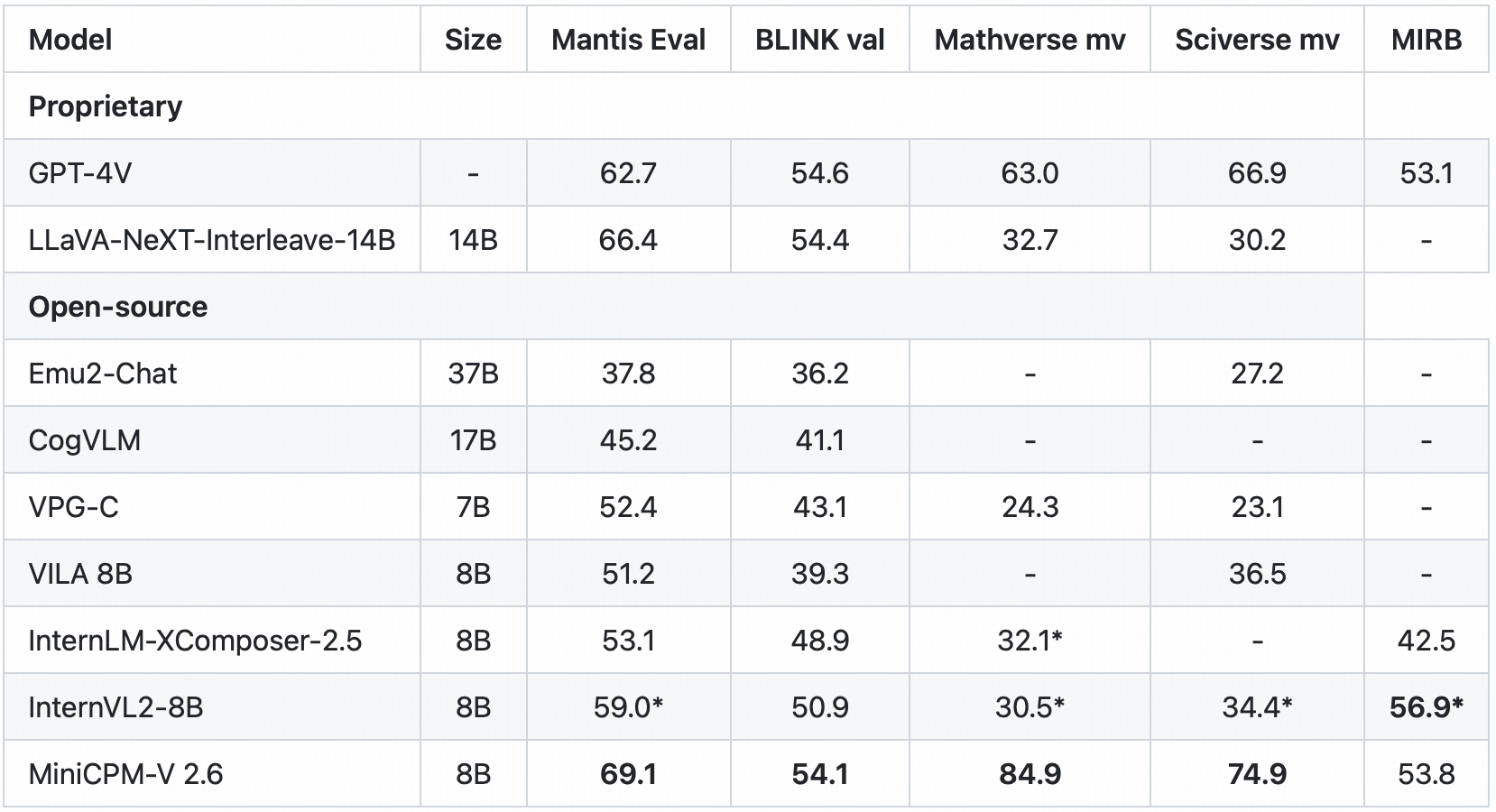🚀 MiniCPM-V-2_6-RK3588-1.1.4
This version of MiniCPM-V-2_6 is optimized for RK3588 NPU, offering high performance with specific quantization.
Dataset and Language Information
| Property |
Details |
| Datasets |
openbmb/RLAIF-V-Dataset |
| Language |
Multilingual |
| Library Name |
transformers |
| Pipeline Tag |
image-text-to-text |
| Tags |
minicpm-v, vision, ocr, multi-image, video, custom_code |
🚀 Quick Start
This version of MiniCPM-V-2_6 has been converted to run on the RK3588 NPU using ['w8a8', 'w8a8_g128', 'w8a8_g256', 'w8a8_g512'] quantization. This model has been optimized with the following LoRA and is compatible with RKLLM version 1.1.4.
Useful Links
✨ Features
Original Model Card for MiniCPM-V-2_6
MiniCPM-V 2.6 is the latest and most capable model in the MiniCPM-V series. Built on SigLip-400M and Qwen2-7B with a total of 8B parameters, it offers significant performance improvements and new features.
- 🔥 Leading Performance: Achieves an average score of 65.2 on the latest OpenCompass, surpassing popular proprietary models like GPT-4o mini, GPT-4V, Gemini 1.5 Pro, and Claude 3.5 Sonnet for single image understanding with only 8B parameters.
- 🖼️ Multi Image Understanding and In-context Learning: Can perform conversation and reasoning over multiple images, achieving state-of-the-art performance on multi-image benchmarks and showing promising in-context learning capability.
- 🎬 Video Understanding: Accepts video inputs, performing conversation and providing dense captions for spatial-temporal information. Outperforms GPT-4V, Claude 3.5 Sonnet, and LLaVA-NeXT-Video-34B on Video-MME with/without subtitles.
- 💪 Strong OCR Capability and Others: Can process images with any aspect ratio and up to 1.8 million pixels, achieving state-of-the-art performance on OCRBench. Features trustworthy behaviors with lower hallucination rates and supports multilingual capabilities.
- 🚀 Superior Efficiency: Shows state-of-the-art token density, improving inference speed, latency, memory usage, and power consumption. Can efficiently support real-time video understanding on end-side devices like iPad.
- 💫 Easy Usage: Can be used in various ways, including local CPU inference, quantized models in different formats, high-throughput inference, fine-tuning, local WebUI demo setup, and online web demo.
Evaluation
Single Image Results
* Evaluated using chain-of-thought prompting.
+ Token Density: number of pixels encoded into each visual token at maximum resolution.
Multi-image Results
* Evaluated the officially released checkpoint by ourselves.
Video Results
Click to view few-shot results on TextVQA, VizWiz, VQAv2, OK-VQA.
* denotes zero image shot and two additional text shots following Flamingo.
+ Evaluated the pretraining ckpt without SFT.
Examples
Click to view more cases.
The model is deployed on end devices. The demo video is a raw screen recording on an iPad Pro without edition.
📚 Documentation
Demo
Click here to try the Demo of MiniCPM-V 2.6.
💻 Usage Examples
Basic Usage
Inference using Huggingface transformers on NVIDIA GPUs. Requirements tested on python 3.10:
Pillow==10.1.0
torch==2.1.2
torchvision==0.16.2
transformers==4.40.0
sentencepiece==0.1.99
decord
import torch
from PIL import Image
from transformers import AutoModel, AutoTokenizer
model = AutoModel.from_pretrained('openbmb/MiniCPM-V-2_6', trust_remote_code=True,
attn_implementation='sdpa', torch_dtype=torch.bfloat16)
model = model.eval().cuda()
tokenizer = AutoTokenizer.from_pretrained('openbmb/MiniCPM-V-2_6', trust_remote_code=True)
image = Image.open('xx.jpg').convert('RGB')
question = 'What is in the image?'
msgs = [{'role': 'user', 'content': [image, question]}]
res = model.chat(
image=None,
msgs=msgs,
tokenizer=tokenizer
)
print(res)
res = model.chat(
image=None,
msgs=msgs,
tokenizer=tokenizer,
sampling=True,
stream=True
)
generated_text = ""
for new_text in res:
generated_text += new_text
print(new_text, flush=True, end='')
Advanced Usage
Chat with Multiple Images
Click to show Python code running MiniCPM-V 2.6 with multiple images input.
```python
import torch
from PIL import Image
from transformers import AutoModel, AutoTokenizer
model = AutoModel.from_pretrained('openbmb/MiniCPM-V-2_6', trust_remote_code=True,
attn_implementation='sdpa', torch_dtype=torch.bfloat16) # sdpa or flash_attention_2, no eager
model = model.eval().cuda()
tokenizer = AutoTokenizer.from_pretrained('openbmb/MiniCPM-V-2_6', trust_remote_code=True)
image1 = Image.open('image1.jpg').convert('RGB')
image2 = Image.open('image2.jpg').convert('RGB')
question = 'Compare image 1 and image 2, tell me about the differences between image 1 and image 2.'
msgs = [{'role': 'user', 'content': [image1, image2, question]}]
answer = model.chat(
image=None,
msgs=msgs,
tokenizer=tokenizer
)
print(answer)
</details>
#### In-context Few-shot Learning
<details>
<summary> Click to view Python code running MiniCPM-V 2.6 with few-shot input. </summary>
```python
import torch
from PIL import Image
from transformers import AutoModel, AutoTokenizer
model = AutoModel.from_pretrained('openbmb/MiniCPM-V-2_6', trust_remote_code=True,
attn_implementation='sdpa', torch_dtype=torch.bfloat16) # sdpa or flash_attention_2, no eager
model = model.eval().cuda()
tokenizer = AutoTokenizer.from_pretrained('openbmb/MiniCPM-V-2_6', trust_remote_code=True)
question = "production date"
image1 = Image.open('example1.jpg').convert('RGB')
answer1 = "2023.08.04"
image2 = Image.open('example2.jpg').convert('RGB')
answer2 = "2007.04.24"
image_test = Image.open('test.jpg').convert('RGB')
msgs = [
{'role': 'user', 'content': [image1, question]}, {'role': 'assistant', 'content': [answer1]},
{'role': 'user', 'content': [image2, question]}, {'role': 'assistant', 'content': [answer2]},
{'role': 'user', 'content': [image_test, question]}
]
answer = model.chat(
image=None,
msgs=msgs,
tokenizer=tokenizer
)
print(answer)
Chat with Video
Click to view Python code running MiniCPM-V 2.6 with video input.
```python
import torch
from PIL import Image
from transformers import AutoModel, AutoTokenizer
from decord import VideoReader, cpu # pip install decord
model = AutoModel.from_pretrained('openbmb/MiniCPM-V-2_6', trust_remote_code=True,
attn_implementation='sdpa', torch_dtype=torch.bfloat16) # sdpa or flash_attention_2, no eager
model = model.eval().cuda()
tokenizer = AutoTokenizer.from_pretrained('openbmb/MiniCPM-V-2_6', trust_remote_code=True)
MAX_NUM_FRAMES=64 # if cuda OOM set a smaller number
def encode_video(video_path):
def uniform_sample(l, n):
gap = len(l) / n
idxs = [int(i * gap + gap / 2) for i in range(n)]
return [l[i] for i in idxs]
vr = VideoReader(video_path, ctx=cpu(0))
sample_fps = round(vr.get_avg_fps() / 1) # FPS
frame_idx = [i for i in range(0, len(vr), sample_fps)]
# The original README seems to be incomplete here, so it remains as is.
















